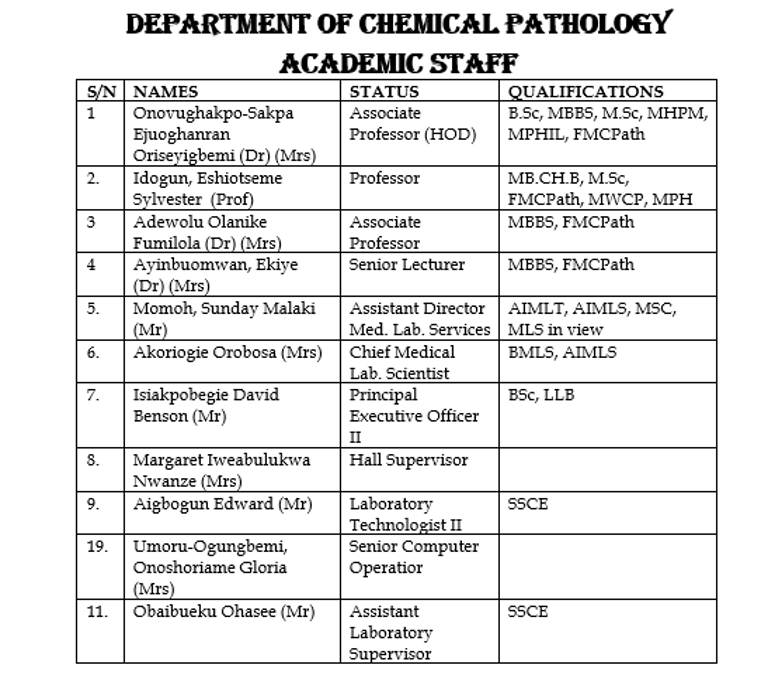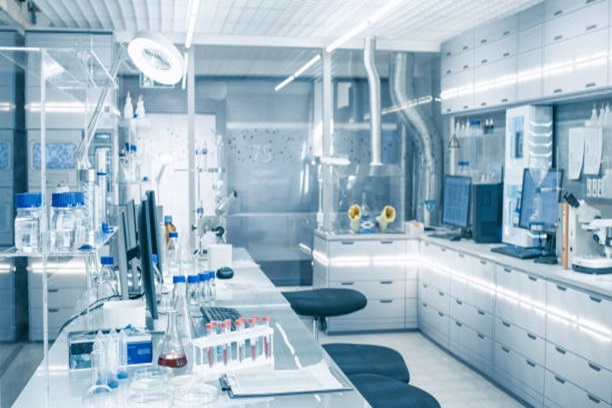
Brief History
Pathology is a very diversified and all-embracing subject. It comprises Morbid Anatomy (Pathology), microbiology, haematology and chemical pathology, which are distinct disciplines themselves.
For a long time after its inception in 1972, the pathology division remained as one department under one administrative headship. Chemical pathology (clinical chemistry or clinical biochemistry as it is sometimes referred to) is a scientifically dynamic and growing discipline in medical practice with room for further development. Chemical pathology along with the other arms that make up the pathology division became separate autonomous and full-fledged departments in June 1979 in order to make room for the much desired growth and development of the discipline. There is still administrative and academic inter-departmental co-operation for the purpose of conducting the comprehensive MBBS Part III pathology examinations.
Aims and Objectives
The Department of Chemical Pathology offers a programme of courses leading to the award of MBBS and BDS degrees of the University of Benin. Chemical pathology forms an integral part of the pathology (MBBS and BDS TIB) comprehensive examinations, which are taken at 400 level. The subject under the course credit/unit system is coded CHP and is taught over a period covering 3 semesters, beginning in the second semester at 300 level. The courses taught should enable the student to understand the following:
(i) How the common clinical disorders of disease may be related to and subdivided into their main biochemical components.
(ii) The relation of biochemistry to common diseases.
(iii) The description, recognition and the biochemistry of diseases associated with abnormalities in metabolism.
(iv) The principles of investigations and interpretation of results of biochemical laboratory investigations.
Syllabus
300 Level
CHP 323: Introduction to Chemical Pathology (1 Credit Unit)
Scope of the discipline. Test requests; types of investigations. Clinician’s contribution to valid results. Interpretation of results, normal or reference values and abnormal results. Units of expressing biochemical results – traditional and SI units. Renal homeostasis and function tests. Water and electrolyte balance; acid-base homeostasis. Principles of biochemical genetics and in-born errors of metabolism. Inborn errors of: (a) amino acids metabolism – phenylketonuria, Hartnup’s disease, MSUD, albinism; (b) carbohydrate metabolism, glycogen storage diseases; (c) urea cycle. Purine metabolism and gout. Disorders of hemopoiesis.
400 Level
CHP 413 & 423 (First and Second Semesters, 2 Credit Units)
Gastric function and disorders of the gastrointestinal tract including the malabsorptlon syndromes. Diagnostic clinical gozymology, generally and in bone, cardiac and muscular disorders. Hepatic liver (iinction tests and jaundice and bilirubin metabolism. Protein metabolism and the paraproteinaemias. Chemical pathology of nutrition. Biochemistry of malignant disease; tumour markers. Carbohydrate metabolism – diabetes mellitus and the hyperglycaemic syndromes. Disorders of carbohydrate metabolism and the hypoglycaemic syndromes. Lipid metabolism and hyperlipoproteinaemias. Introduction to clinical endocrinology – mechanisms of hormonal action. Hypothalamic, pituitary and adrenocortical hormones. Disorders and investigations of the HPA axis. Congenital adrenal hyperplasia. Thyroid function and tests. The gonads and obstetric endocrinology, APUD system. Calcium, phosphorus and magnesium metabolism in hereditary disease. Trace metal metabolism and disorders in clinical diagnosis. Investigation of cercbrospinal fluid (CSF). Radioisotopes in laboratory medicine. Metabolic response to stress. Total parenteral nutrition and its laboratory monitoring. Introduction to clinical toxicology and therapeutic monitoring.
CHP 414 & CHP: Practical in Chemical Pathology (First and Second Semesters, 3 Credit Units)
Specimen collection and preservation of urine, stool and blood. Containers or specimen tubes for specimen collection. Elementary biostatistlcs and data processing. Quality control schemes, accuracy, precision, etc. Theory of chemical analysis — qualitative and quantitative, analysis of normal and abnormal constituents in blood, urine and stool: (i) proteins and reducing substances in urine; (ii) proteins and glucose in plasma; (iii) pigments, bilirubin and metabolites in urine. Detection of ketone bodies in urine. Spectroscopy and haemoglobin and haemoglobin derivatives. Chromatographic and electrophoresis techniques and their uses in chemical analysis and clinical diagnosis. Demonstration of Na+, K+, estimation by flame photometry.
IDP 430 (2nd Semester, 1 Credit Unit)
Interdepartmental posting in chemical pathology. More demonstrations in routine laboratory methodologies. Tutorials, case reports and problem-solving sessions.
Course Objectives
The objective of the course is to enable the students to acquire the theoretical and practical knowledge of the disorders of blood and understanding of the blood group. Specifically, at the end of the haematology course the student should be able to undertake the following:
1. Identify patients with red blood cell disorders such as sickle cell anaemia, white cell disorders such as the acute and chronic leukaemias, coagulation disorders such as haemophilia A and disseminated intravascular coagulation.
2. Students should be able to make blood and bone marrow films using Leishman stain. In addition to this students are expected to identify the various haematological disorders using the blood film and bone marrow film.
3. Students are expected to perform and identify the ABO and rhesus blood groups.
4. Students are expected to perform the various tests for coagulation such as prothrombin time and activated partial thromboplastin time.

Recent Comments